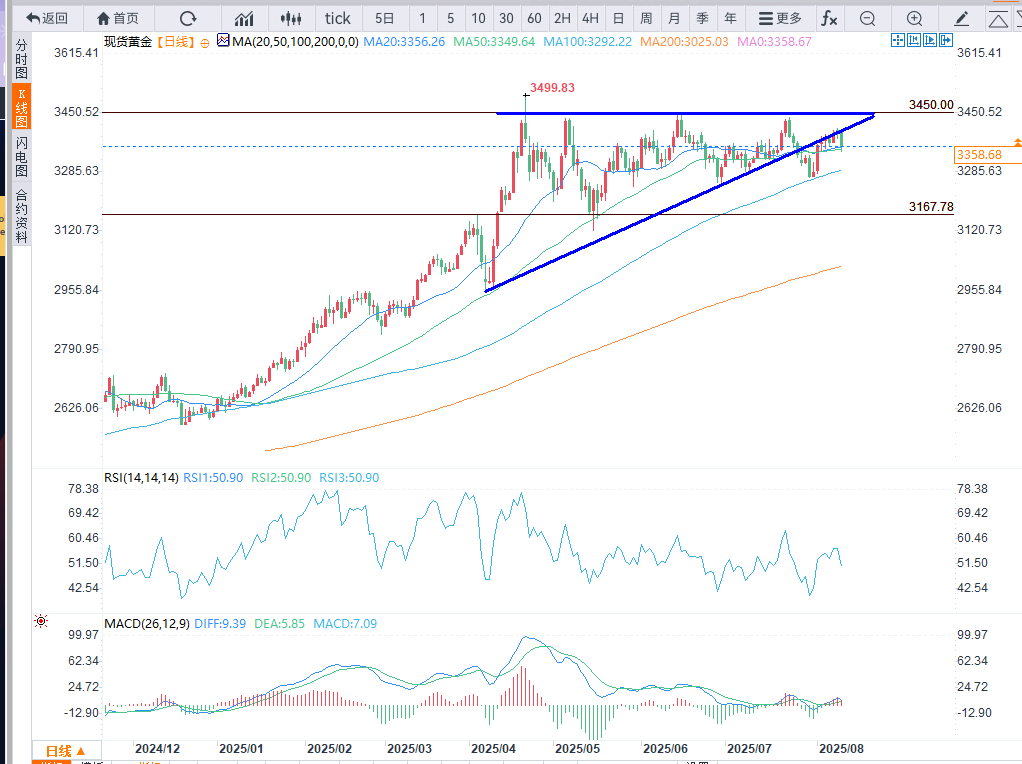Gold prices fell below $3,350 as the market awaited clarification on tariff policy and inflation data.
2025-08-12 01:50:04

Gold price dynamics: Market sentiment turns cautious
U.S. gold futures for December delivery fell 2.4% to $3,407.60 an ounce as of 12:15 p.m. ET (16:15 GMT) on Monday. Spot gold fell 1.5% to $3,347.49 an ounce, retreating from a record high reached last Friday.
"The market initially rallied on uncertainty about tariffs, but now there's been nervous selling as participants await further clarification from the White House," said Jim Wyckoff, senior analyst at Kitco Metals. He further noted that the sell-off reflected investors' caution about policy uncertainty, especially after gold prices hit a record high last Friday on tariff rumors, and market sentiment quickly turned to wait-and-see.
Last Friday, reports that the United States might impose country-specific import tariffs on the most widely traded gold bars, such as 1 kilogram and 100-ounce bars, sent shockwaves through the market, sending gold prices soaring. However, that evening, White House officials told Reuters that the administration would soon issue an executive order to clarify "misinformation" regarding tariffs on gold bars and other specialized products. This statement eased market concerns about supply chain disruptions, but also led some investors to take profits, pushing gold prices back down.
Wyckoff added: "The expectation of clarification from the White House has caused the market to shift from initial panic buying to a wait-and-see approach. In the short term, gold prices may continue to fluctuate until the policy details become clear."
Geopolitical optimism dampens safe-haven demand
Gold prices also fell on optimism about easing geopolitical tensions. U.S. President Trump announced on Friday that he would meet with Russian President Vladimir Putin in Alaska on August 15 to discuss a possible end to the Russia-Ukraine conflict.
Optimism about potential progress in U.S.-Russia peace talks in Ukraine, along with strong stock markets, curbed safe-haven demand for gold, with investors turning to riskier assets. The diplomatic development boosted global risk appetite, weakening gold's appeal as a traditional safe-haven asset.
However, the prospects for peace talks are not without challenges. Russia demands recognition of its annexed territories, Ukrainian neutrality, and the lifting of sanctions, while Ukraine insists on a complete ceasefire, the recovery of all territory, and solid security guarantees. White House officials have stated that Trump is open to a three-way summit with Putin and Ukrainian President Volodymyr Zelensky, but currently plans are for bilateral talks only.
Despite recent optimism stemming from diplomatic progress, the significant gap between the two sides' positions could complicate negotiations and limit gold's downside. Geopolitical uncertainty remains a potential supportive factor for gold prices.
Federal Reserve interest rate expectations and key economic data
Market expectations for a September rate cut by the Federal Reserve have further solidified, providing some support for gold prices. According to the CME FedWatch tool, the market currently expects an 88% probability of a 25 basis point rate cut in September, reflecting investors' growing confidence in the Fed's loose monetary policy.
Wyckoff pointed out: "This week's inflation data is particularly important after the recent weak employment report. If the inflation data is higher than expected, it may prompt the Federal Reserve to pause its September interest rate cut, which will be bearish for gold prices." He emphasized that gold generally performs well in a low-interest rate environment because lower interest rates reduce the opportunity cost of holding non-yielding assets such as gold.
This week's packed schedule of US economic data is the focus of market attention. Tuesday will see the release of the Consumer Price Index (CPI), Thursday will see the release of the Producer Price Index (PPI), and Friday will also feature retail sales data and the preliminary University of Michigan Consumer Confidence Index.
The data will provide key clues to inflation trends and the Fed's policy path, especially as market concerns about an economic slowdown have intensified amid recent weak jobs data.
US dollar and global stock market performance
The US dollar index (DXY) remained stable at 98.60 on Monday, close to a two-week low, limiting further declines in gold prices. The US dollar index stabilized above 98.00 but lacked significant upward momentum, which provided some support for gold.
Global stock markets performed strongly due to geopolitical optimism and positive corporate earnings reports. Japan's Nikkei 225 index rose 1.85% on Friday, with futures prices nearing a record high. The UK's FTSE 100 index rose 0.26% to 9,118 points on Monday, while India's Sensex index rose 746 points to close at 80,604. The rise in global stock markets reflects investors' increased appetite for risky assets, further weakening gold's safe-haven demand.
Meanwhile, U.S. Treasury yields stabilized on Monday, with the 10-year Treasury yield hovering around 4.262% and the 30-year yield falling back to 4.825%, ending a three-day rally. The stability of yields also limited the further strength of the U.S. dollar, indirectly providing support for gold prices.
Trade Policy and Tariff Impact
Progress in trade negotiations also impacted gold prices. On August 7, the United States officially implemented retaliatory tariffs on over 60 trading partners, raising the overall tariff rate to 18.6%, the highest level since 1934. Meanwhile, the 90-day tariff truce between the United States and China expires on August 12, and the market awaits President Trump's decision on whether to extend the agreement to allow for continued negotiations.
While rising trade tensions could reignite safe-haven demand for gold, investors are currently focused on the White House's clarification regarding tariffs on gold bars. Last week, rumors circulated that the US might impose new tariffs on widely traded gold bars, including Swiss ones, sparking concerns about supply chain disruptions. However, the White House subsequently announced it would issue an executive order clarifying that gold bars would be exempt from such tariffs.
The White House's statement provided a lifeline to the market, but investors are still waiting for a formal announcement to confirm policy details, which may continue to affect the short-term fluctuations in gold prices.
Technical analysis: Key support and resistance for gold prices

(Source of spot gold daily chart: Yihuitong)
From a technical perspective, gold came under pressure on Monday, extending its decline from last week's failure to break above the psychologically important $3,400 level. On the daily chart, gold is encountering selling pressure at the uptrend line of an ascending triangle pattern. Despite a brief break below this trendline in late July, the lack of follow-through has kept the overall bullish structure intact. Currently, the price is finding support near the 50-day simple moving average (SMA), at $3,350. A break below this level could lead to further testing of the 100-day SMA ($3,292) and stronger horizontal support at $3,250.
Looking up, $3,400 remains the first resistance level for buyers, a break of which could challenge the all-time high of $3,500.
The relative strength index (RSI) has retreated to the neutral level of 50, suggesting a lack of strong directional momentum. The moving average convergence-divergence (MACD) indicator maintains a slightly bullish bias, but the narrowing histogram suggests fading buying pressure.
Investors should pay close attention to this week's CPI and PPI data, as well as the developments of the US-Russia summit on August 15, as these events may determine whether gold prices can resume their upward trend.
Amidst the current high uncertainty, gold remains an asset worth watching, but it may fluctuate in the $3,350 to $3,400 range in the short term.
- Risk Warning and Disclaimer
- The market involves risk, and trading may not be suitable for all investors. This article is for reference only and does not constitute personal investment advice, nor does it take into account certain users’ specific investment objectives, financial situation, or other needs. Any investment decisions made based on this information are at your own risk.





















